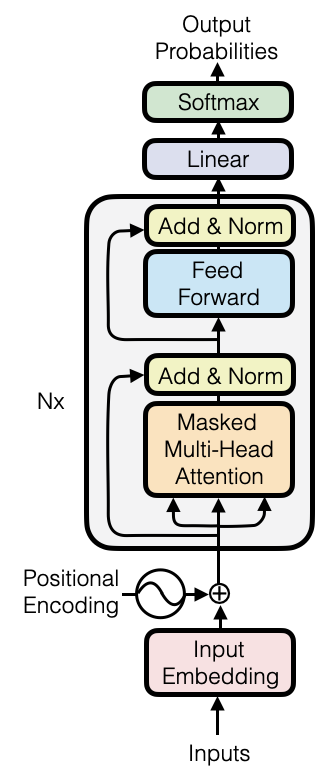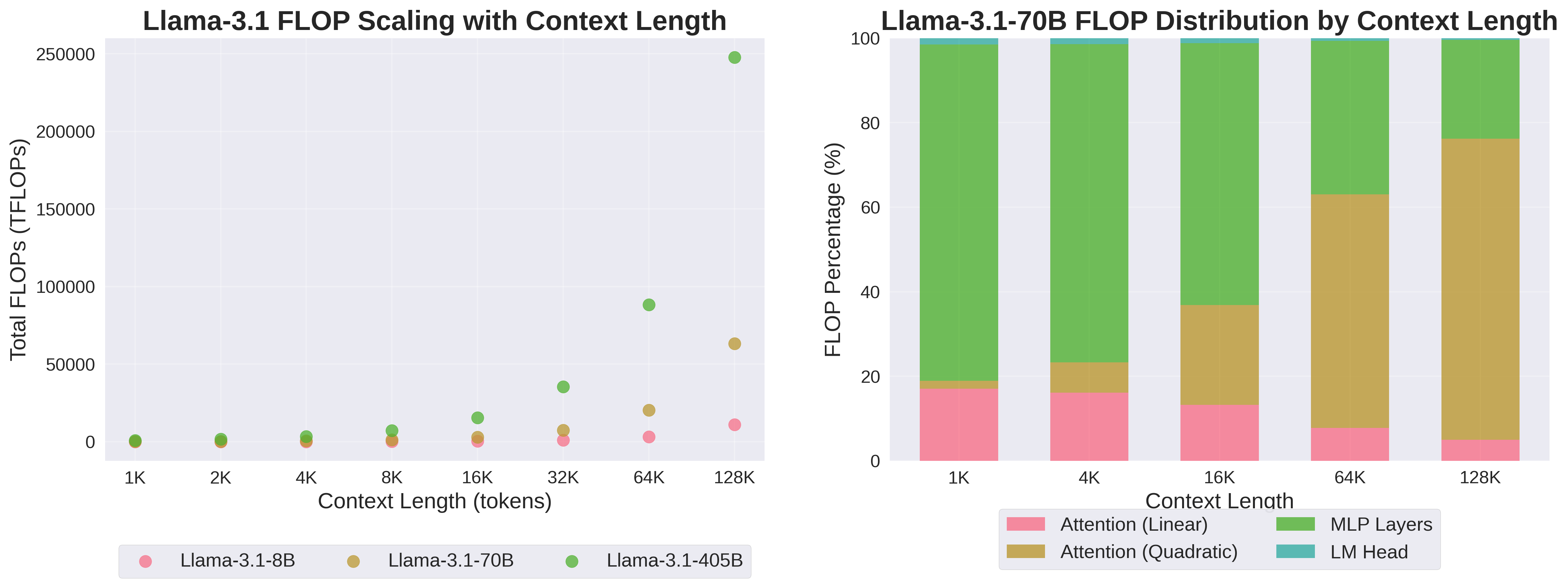Introduction to Language Models and Inference
Graham Neubig


Language Models Permeate Our Lives
- General Assistants: ChatGPT, Google Search
- Code Completion: Copilot, Cursor
- Coding Agents: Codex, Jules, OpenHands
- Specialized Apps: Harvey (Legal), Abridge (Medical)
- etc. etc.
What Is a Language Model?
- A model that assigns probabilities to sequences of tokens
- \(P(x)\) for a sequence \(x = x_1, x_2, \ldots, x_L\)
- Most common: autoregressive models
- \(P(x) = P(x_1) P(x_2 \mid x_1) P(x_3 \mid x_{\lt 3}) \ldots P(x_L \mid x_{\lt L})\)
- Some counter-examples: energy-based models/diffusion models
Example: Unconditioned Completions
Generated from BOS token (Qwen3-1.7B-Base):
- Highest Probability:
- “3.” (-4.22)
- “4.” (-4.50)
- “0)” (-7.01)
- Middle Probability:
- “8 \text{ dollars} - 5 \text{ dollars} = 3 \text{ dollars}” (-20.31)
- “3 \) because \( 2^3 = 8 \) and \( 2^{-3} = \frac{1}{8} \” (-22.53)
- “1) = (x + 2) - (x + 1) = 1” (-23.03)
- Lowest Probability:
- “2015—2016 学年度下学期期末统考 高三文科数学 2016.06” (-35.62)
- “为深入贯彻落实关于党史学习教育"办实事、开新局"的要求,按照公司党委关于党史学习教育的部署,7月6日,公司” (-47.32)
- “本篇博文主要针对在使用MySQL数据库进行数据库操作时遇到的问题进行记录和总结。包括:” (-56.30)
Conditional Probability
- Often we want \(P(x_{\ge n} \mid x_{\lt n})\)
- Also written as \(P(y \mid x)\)
- \(x_{\lt n}\) (or \(x\)) is the prefix or query
- \(x_{\ge n}\) (or \(y\)) is the completion or response
- Mathematically, omit the first \(n\) tokens of \(x\) in the product:
- \(P(x_{\ge n} \mid x_{\lt n}) = P(x_{n} \mid x_{\lt n}) P(x_{n+1} \mid x_{\lt n+1}) \ldots P(x_{L} \mid x_{\lt L})\)
Example: Conditional Completions
Prompt: “The best thing about Carnegie Mellon University is”
- Highest Probability:
- " its diversity." (-5.00)
- " that it’s a community." (-9.87)
- Middle Probability:
- " its location and the vibrant community it has built." (-18.13)
- " that there’s always something else to learn." (-18.50)
- " that it gives you the ability to take your education to the next level." (-20.02)
- Lowest Probability:
- " its focus on the interdisciplinary approach, with students majoring in computer science, mathematics and engineering." (-38.92)
- " the community that you get in it, with so many people doing so many different things." (-39.69)
- " not just its academics and research in engineering, computer science and business — it’s the amazing, out-of-the ordinary experiences your students create in the classroom" (-68.35)
Modeling
- How to model \(P(x_n \mid x_{\lt n})\)?
- Typically Transformer models
- Other options exist, e.g. MoEs, RNNs, or Mamba

Modeling Cost
- Self-attention: quadratic in sequence length \(L\)
- Feed-forward layers (FFN): wide and heavy
- \(N\) layers: total cost scales linearly with \(N\)

FLOPs per Layer (GQA Transformer)
- Variables: \(L\) (tokens), \(d\) (hidden size), \(H\) (heads), \(H_{kv}\) (KV heads), \(d_h = d/H\), \(d_{ff}\) (FFN size)
- Self-attention FLOPs per layer (with GQA):
\[\underbrace{2L\,d^2}_{\text{Q proj}}
+\underbrace{2L\,d \cdot H_{kv} d_h}_{\text{K proj}}
+\underbrace{2L\,d \cdot H_{kv} d_h}_{\text{V proj}}
+\underbrace{4H\,L^2\,d_h}_{QK^T + AV}
+\underbrace{2L\,d^2}_{\text{output proj}}\]
- Feed-forward FLOPs per layer (SwiGLU):
\[\underbrace{2L\,d\,d_{ff}}_{\text{gate}}
+\underbrace{2L\,d\,d_{ff}}_{\text{up}}
+\underbrace{2L\,d_{ff}\,d}_{\text{down}}\]
e.g. Llama-3.1 Series
| Model | Parameters | Layers | Hidden Size | Attention Heads | KV Heads | MLP Size |
|---|---|---|---|---|---|---|
| Llama-3.1-8B | 8.0B | 32 | 4,096 | 32 | 8 | 14,336 |
| Llama-3.1-70B | 70.6B | 80 | 8,192 | 64 | 8 | 28,672 |
| Llama-3.1-405B | 405.9B | 126 | 16,384 | 128 | 8 | 53,248 |
FLOPs vs Context Length

- Total FLOPs scale quadratically with context
- MLP dominates for short sequences, attention for long
Hardware
- CPU: General-purpose, but typically too slow for LLMs
- NVIDIA GPU: Parallel processing, high memory bandwidth
- A100, H100, B200: server-grade, fast, expensive
- 3090, 4090, A6000: consumer-grade, still pretty fast, cheaper
- TPU: Google’s tensor processing unit, optimized for matrix operations
- Cerebras, Groq: Specialized hardware for LLMs, high memory bandwidth
Training Language Models
- Train on large corpora of text
- Goal: learn parameters \(\theta\) such that \(P_\theta(x)\) approximates the true distribution
- Use maximum likelihood estimation (MLE)
- \(\theta^* = \arg\max_\theta \sum_{x\in\mathcal D} \log P_\theta(x)\)
Training Steps
- Forward pass: compute \(P_\theta(x)\)
- Backward pass: compute gradients \(\nabla_\theta \log P_\theta(x)\)
- Parameter update: \(\theta \leftarrow \theta + \eta \nabla_\theta \log P_\theta(x)\)
- \(\eta\) is the learning rate
- Practically: process large batches of text w/ tensor operations
Training Illustration
Inference with Language Models
- Given a prompt \(x\), generate a continuation \(y\)
- Two main approaches:
- Sampling: draw samples \(y' \sim P_\theta(y \mid x)\)
- Search: approximately find \(\hat{y} \leftarrow \arg\max_y s_\theta(y \mid x)\)
- \(s\) may or may not be \(P\)
Inference Illustration
Basic Generation
- Also called “decoding” (from information theoretic roots).
- Often done one token at a time, autoregressively. Simplified view:
def generate(model: Model, x: list[Token]):
y = []
while not done(y): # while termination condition not reached
p = model(x + y) # get P(y | x)
y.append(sample(p)) # sample or search for next token
return y
- We will cover many variants in this course!
Meta-generation
- A class of algorithms that generate token sequences as a subroutine.
- Most common: reranking.
def generate_and_rerank(model: Model, reranker: Reranker, candidate_count: int, x: list[Token]):
# generate candidate_count candidates
candidates = [generate(model, x) for _ in range(candidate_count)]
# score each with the reranker
scores = [reranker(x, y) for y in candidates]
# return the highest-scoring candidate
return candidates[argmax(scores)]
- We will cover many other algorithms!
Latent Variables
- Sometimes we want to model things other than the actual answer.
- Most common: chain of thought.
| Variable | Example |
|---|---|
| Input \(x\) | “How many years since the Transformer paper was published?” |
| Latent \(z\) | “Now is 2025 and the Transformer paper was published in 2017. 2025 - 2017 = 8.” |
| Output \(y\) | “It has been 8 years since the Transformer paper was published.” |
- Latent variables pose many issues! (efficiency, marginalization)
Evaluation of Inference Outputs
- We don’t want high-probability outputs, we want good outputs
- Human Preference: Ask humans to judge outputs according to a rubric
- LLM as a Judge: Ask an LLM to evaluate outputs according to a rubric
- Deterministic Metrics: accuracy, BLEU, ROUGE, etc.
- Also called “reward” in reinforcement learning, \(r(y \mid x)\)
Search Errors vs. Model Errors
- Search Error: Search algorithm fails to find output w/ highest model score
- \(s(\text{generate}(\theta, x) \mid x) < \max_y s_\theta(y \mid x)\)
- Can be mitigated by better inference
- Model Error: The model scores a worse output better than the best output
- \(\hat{y} = \arg\max_y s_\theta(y \mid x)\)
- \(r(\hat{y} \mid x) < \max_y r(y \mid x)\)
- Can be mitigated by better model training or inference
- Know which one you are facing!
Diversity vs. Quality
- Argmax search gives low diversity, sometimes higher quality
- Sampling gives high diversity, sometimes lower quality
Recap: Inference Desiderata
- Good evaluation scores
- Low latency
- High throughput
- High diversity
- Depending on the application, priorities may vary!
This Course: 1. Inference Basics
- Introduction to Language Models and Inference
- Probability Review and Shared Task Introduction
- Common Sampling Methods for Modern NLP
- Beam Search and Variants
- Intro to A* and Best First Search
- Other Controlled Generation Methods
This Course: 2. Reasoning, Tool Use, and Agents
- Chain of Thought and Intermediate Steps
- Self-Refine and Self-Correction Methods
- Reasoning Models
- Incorporating Tools
- Agents and Multi-Agent Communication
This Course: 3. Scaling Inference Time Compute
- Minimum Bayes Risk and Multi-Sample Strategies
- Reward Models and Best-of-N
- Systems not Models
- Inference Scaling vs Model Size
- Using External Verifiers
- Token Budgets and Training-Time Distillation
This Course: 4. System-Level Optimization
- Defining Efficiency
- Library Implementations and Optimizations
- Prefix Sharing and KV Cache Optimizations
- Draft Models and Speculative Decoding
- Linearizing Attention and Sparse Models
- Transformer Alternatives
What Won’t We Cover?
- Model training is limited (only together w/ inference)
- Model architectures are limited
- Model evaluation is limited
- Inference on non-text data is limited
Grading
- 15% Quizzes (given most weeks)
- 60% Assignments (3 total)
- 25% Final Project
Shared Tasks
- 3 tasks that can be solved with language models
- Mathematical reasoning
- Multiple choice question answering
- Open-ended generation
- Details to be released soon
Assignments and Schedule
- HW1: generation algorithms
- HW2: meta-generation algorithms
- HW3: hardware & optimization
- Final Project: inference server
Questions + Discussion
Carnegie Mellon University - Language Model Inference - Fall 2025